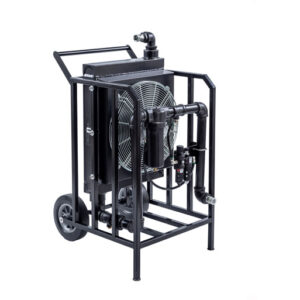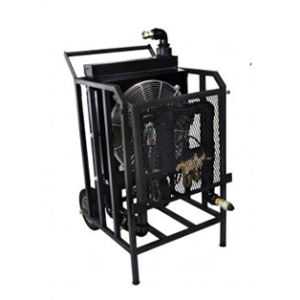Wickens Dry Ice Blasting
As a leader in the dry ice blasting industry, we’ve produced our own line of air preparation units to help you reduce moisture problems on your projects and extend the life of your investment in dry ice blasting equipment.
Compressed Air Principles
Portable diesel compressors take ambient air and compress it for industrial use. Generally, the air from one of these compressors is sufficient to run most industrial equipment. The air is pre-filtered, then compressed, put through an air/oil separator to remove any suspended oil particles, and delivered to the outlet. Jackhammers and the like do not require any more air preparation than that, but dry ice blasting equipment contains small orifices, seals, and gaskets that, if exposed to the air as it is delivered from the compressor, will rapidly deteriorate and require repair.
A Look at the Air Received from a Portable Diesel Compressor
The air from a compressor is HOT. Diesel compressor outlet air will have a temperature in excess of 100° F above ambient. On a hot day, the outlet temperature can reach 180° F. These temperatures will rapidly destroy standard air hoses and diaphragms in the equipment.
The air is WET. As the compressor gathers air from the atmosphere it is also pulling in all the humidity with it. All the water remains in the compressed air. The combination of high humidity and high temperature results in hot air that is super saturated with moisture.
The air is full of OIL from the compressor. The air – oil separator in the compressor is only designed to conserve oil for the compressor, not remove the oil for the consuming appliances. In fact, jackhammers depend on the oil from the compressor to give them some lubrication.
What Wickens Air Preparation Units Accomplish
The hot, wet, oily air from the compressor is first passed through an air to air heat exchanger which cools the air back down to just above ambient. The compressed air is cooled by ambient air, not chilled, the system therefore is inexpensive and very portable.
The cooled air is then passed through a water filter/separator. This unit causes the air to swirl around the outside of the bowl. Water and oil are centrifugally separated from the air and flow down the outside of the bowl to collect in the bottom. A manual drain periodically purges the fluid. Integral to the system is a sintered bronze filter that removes particles greater than 40 microns.
Some of the cooled and separated air is used to drive the air motor for the fan and the rest is delivered to the air supply hose. A small amount of oil will still be present in the air and the air will still contain some moisture. But the amount of both left in the air is inconsequential for the majority of blast operations.
Some conditions will arise where either more oil or water needs to be removed. If more oil needs to be removed, then a coalescent filter can be installed after the air preparation unit. If more water needs to be removed, then a desiccant canister dryer can be installed. Both of these are readily available as a standalone add-on.
Showing all 2 results



Recent Comments